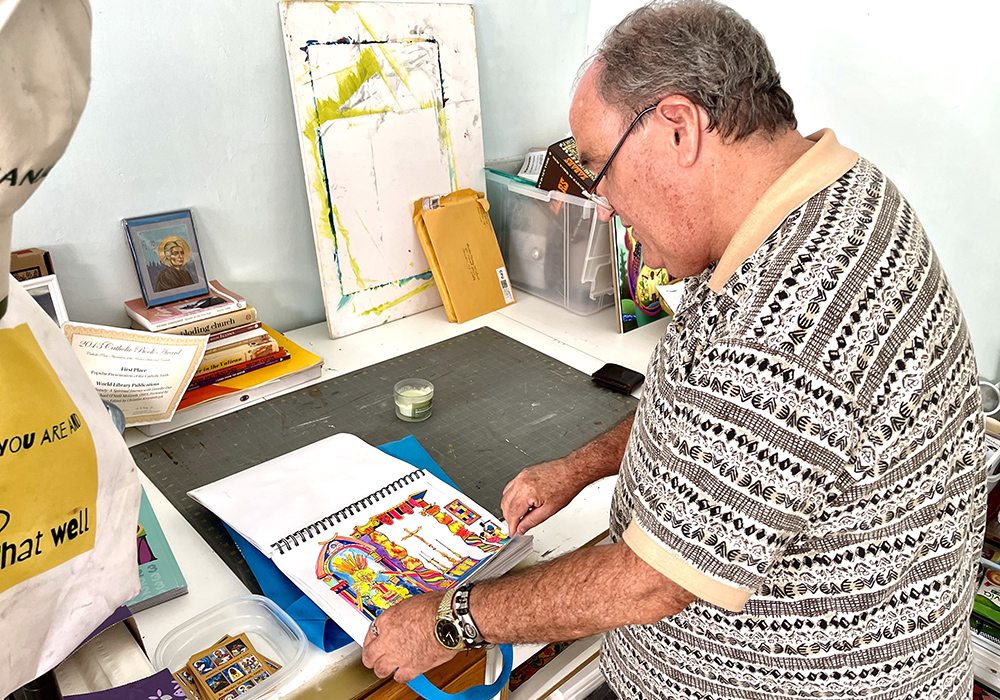
Oblate of St. Francis de Sales Br. Mickey McGrath is pictured in his studio in Camden, New Jersey, in August. (NCR photo/Camillo Barone)
In the spring of 1988, Br. Mickey McGrath lost his voice.
An Oblate of St. Francis de Sales since 1977, he had been teaching art history and studio art for more than five years at DeSales University in Center Valley, Pennsylvania, and without his voice he was often forced to cancel his classes and send students home earlier.
Just nine months before, in 1987, his mother died of leukemia, which also led then-30-year-old McGrath to enter a hypochondriac spiral within a short time.
After a specialist reassured him that he did not have throat cancer, and that perhaps the reason for the loss of his voice might be related to simple stress-related reasons, McGrath went to visit a fellow member of his congregation, Fr. Jim Murphy, who was bedridden and near death. When McGrath walked into the room, Murphy said, "Mickey, I am glad you are here. I was just speaking to your mother!"
In the course of the visit, Murphy told McGrath several things which, he said, his mom wanted McGrath to know: that she didn't want him to be unhappy; that he should accept the gifts people want to give him and say, "Thank you, Jesus!" and, above all, that he should do what he loves to do the most in life, namely producing sacred art.

A sketch of St. Peter's Square that Br. Mickey McGrath made during his trip to Rome in 2023. (NCR photo/Camillo Barone)
In addition to the loss of his voice, McGrath indeed struggled with a growing dissatisfaction with his job as an art teacher. That afternoon, through the words of Murphy — for whom McGrath had deep esteem and trust — McGrath began to seriously discern a desire to leave teaching and dedicate himself to sacred art forever. After obtaining permission from his congregation, McGrath left DeSales University in 1994 and started a long career that to this day has led him to be one of the leading proponents of contemporary sacred art in the United States.
McGrath's peculiar specialty is to combine traditional Christian forms of sacred art with the instances of social and racial minorities living in the United States and around the world, such as African American and Native American communities, as well as with the values of Christian interdenominational and interfaith dialogue.
"I just felt a call. I just found my journal that I started when I was a novice at the age of 20, when I started prayer journaling. In the very first page, it said, 'I want to be the next Thomas Merton,' " McGrath told the National Catholic Reporter in his first time opening the doors of his studio in Camden, New Jersey, to a news outlet to profile his career and vocation.
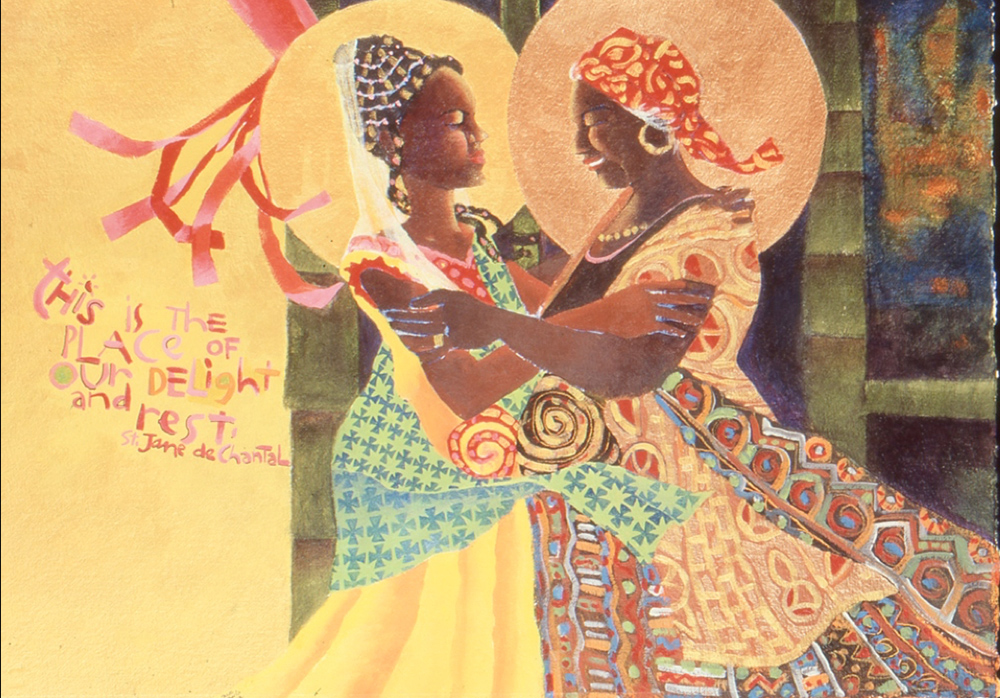
Inspired by the Sisters of the Visitation in Minneapolis and their predominantly Black neighborhood, Br. Mickey McGrath was commissioned to create a painting of the Visitation that reflected the diverse women of the area. (Courtesy of Mickey McGrath)
"I realized I wanted to be a brother, not a priest, because art was becoming alive in a whole different way through the mystical and the spiritual, and not into the institutional and legalistic side of the church. This felt freer; it got the more feminine side of it."
McGrath's journey as an artist began in his childhood, inspired by his father who worked for Sears department store and would bring home paper that McGrath would draw on, sparking his early interest in art. Recognizing his passion, his parents supported him by providing books on drawing, and eventually, his father set up a drawing table in the basement of their northeast Philadelphia home, turning it into Mickey's personal studio. McGrath kept this drawing table which has a spot in his Camden studio.
Throughout high school, he spent hours drawing in what became his personal space, although he dreaded the idea of high school itself, particularly because it lacked art classes. Attending a high school run by the Oblates, where he didn't fit in due to his shyness and nonathletic nature, McGrath saw a turning point in his adolescence when his father discovered art classes for young people at Moore College of Art in downtown Philadelphia.

A view of Oblate of St. Francis De Sales Br. Mickey McGrath's studio in Camden, New Jersey, in August. (NCR photo/Camillo Barone)
" 'Do you think you'd be interested in that?' my father asked me. Three hours later, we were downtown, signing me up for art classes," McGrath said, adding that at Moore he was able to interact with children from diverse backgrounds — an experience that contrasted sharply with the predominantly white environment of his Catholic boys' high school. These interactions played a significant role in shaping his worldview.
McGrath felt a calling to religious life and initially considered becoming a Franciscan before deciding that the Oblates were the right fit for him. During his novitiate year, he was greatly influenced by an aunt who was a Sister of St. Joseph. She had embraced the changes brought by the Second Vatican Council with enthusiasm and embodied "a down-to-earth, human side of religious life" that appealed to McGrath.
"I just felt a call. I just found my journal that I started when I was a novice at the age of 20, when I started prayer journaling. In the very first page, it said, 'I want to be the next Thomas Merton.' "
—Br. Mickey McGrath
One of the first "revelations" McGrath said he had during his years teaching at DeSales University occurred in 1987, when after turning 30 he learnt about the Grünewald Guild, a Christian interdenominational and interfaith art community in the Cascade Mountains of Leavenworth, Washington, which offers weeklong classes in any number of art disciplines.
Excited by the prospect, he discussed it with his parents, planning to seek funding to attend. However, as the time approached, his mother's health began to deteriorate, leading McGrath to question whether he should proceed with his plans. Despite her illness, his mother encouraged him to go, knowing how much it meant to him.
McGrath spent a week and a half at the guild before receiving a call from his father, urging him to return home as his mother's condition had worsened. McGrath made it home in time, and his mother lived for about two more weeks. During this period, McGrath mustered the courage to ask his mother if he could design the liturgy cover for her funeral. She was thrilled by the idea, knowing exactly what she wanted for the music and the arrangements, "as if she had been waiting for someone to take on that role."
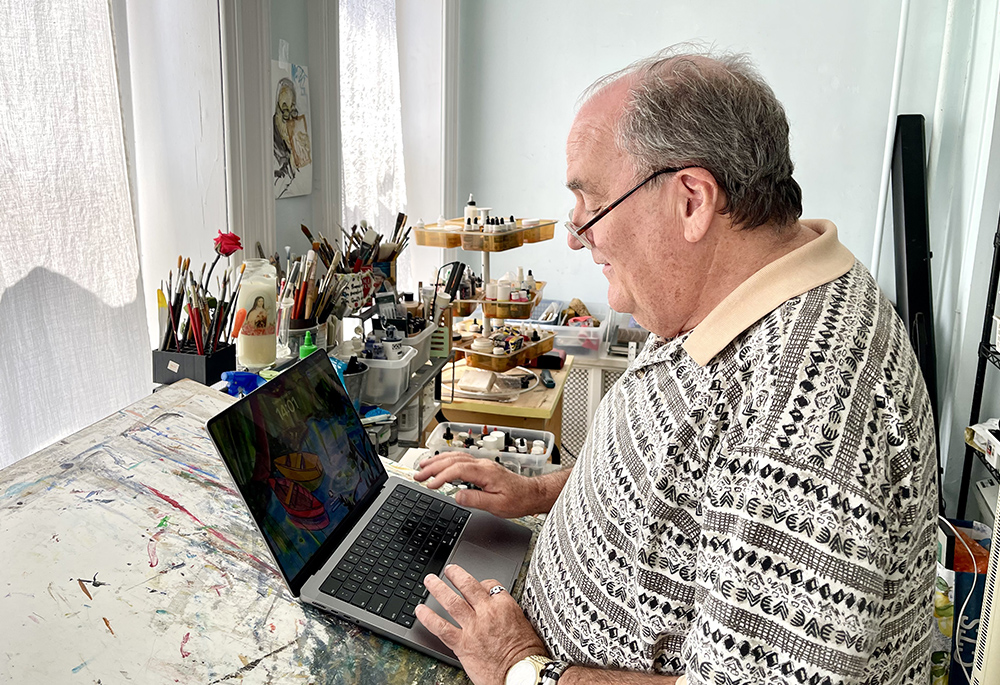
Oblate of St. Francis de Sales Br. Mickey McGrath is pictured in his studio in Camden, New Jersey, in August. (NCR photo/Camillo Barone)
McGrath returned to the Grünewald Guild for a second summer in 1988. Despite being the only Catholic in an interfaith community, primarily composed of Lutherans, McGrath found that his time at the guild was more about deepening his spirituality than honing his artistic skills. Over nearly 38 years, he said he developed close relationships with people of various faiths, discovering that they had far more in common than differences.
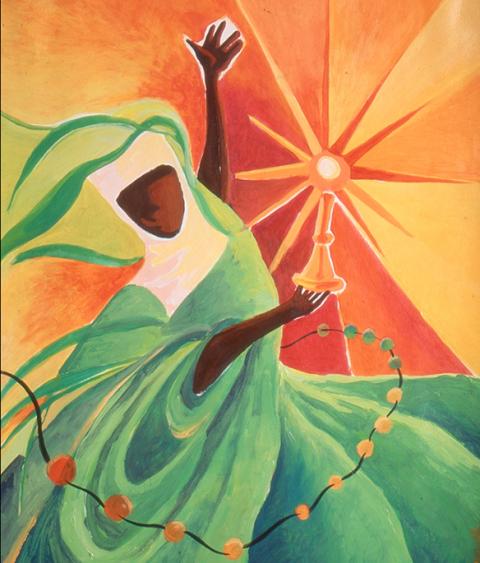
A pivotal moment in Br. Mickey McGrath's journey came when he encountered the story of Franciscan Sr. Thea Bowman. Over two weeks, he created nine paintings inspired by scenes from her life. (Courtesy of Mickey McGrath)
In 1991, after his father's death four years after his mother's, McGrath found himself in a period of intense personal reflection. What he called "a life-changing trip" to Ireland, specifically designed for artists and photographers, helped him confront his grief and embrace his artistic calling more fully. During this trip, he felt deeply connected to the land and his Celtic heritage, leading to a creative outpouring that emphasized the importance of moving forward and sharing his gifts with the world. This revelation pushed him to explore his art in new ways, even as he questioned whether he should return to teaching due to initial struggles with his landscape paintings.
A pivotal moment in McGrath's journey came when he encountered the story of Franciscan Sr. Thea Bowman, a black Catholic nun known for her powerful advocacy for racial justice at that time in the United States. McGrath first learned about Bowman through an article in U.S. Catholic magazine, while he was taking care of his father in hospice care a few weeks before his death.
Advertisement
"I couldn't sleep that night. I had over me the power of this woman," said McGrath. "The next morning, I got up and I started painting. Over the course of two weeks, nine paintings emerged inspired by scenes from her life, as little as I knew of it at that time in a very different style than I'd ever painted in before."
As McGrath met Bowman's friends and relatives in person in Mississippi, he discovered stories from the years of racial segregation related to the Catholic Church in the United States that shocked him, including that until the 1960s, many Black Catholics were forced to sit in the back pews of churches and that they could not take Communion until after waiting for white fellow parishioners to be done.

"Our Lady of Sorrows" represents Mary as an older Black woman in light-colored clothing, immersed in nocturnal landscapes. (Courtesy of Mickey McGrath)
McGrath began sharing these paintings, sending them to various religious figures and communities connected to Bowman, eventually leading to widespread recognition of his work. He began organizing events where his paintings were displayed alongside the spiritual music that Bowman cherished, creating a fusion of art, music and storytelling that resonated with audiences across the country. This work brought McGrath into close contact with Bowman's community for more than 10 years and deepened his commitment to promoting racial justice and harmony through his art.
In 1999, McGrath took a sabbatical that marked a turning point in his artistic and spiritual journey. He spent three months living with the Sisters of the Visitation in Minneapolis, a time he described as both freeing and challenging. Initially, McGrath struggled with the notion that he should be accomplishing something tangible, such as writing a book, but the sisters helped him realize the importance of embracing the sabbatical's true purpose: rest and renewal. This shift in mindset allowed him to immerse himself in his art, leading to the creation of large-scale images of Mary depicted in various racial identities, which later became the basis for his first book.
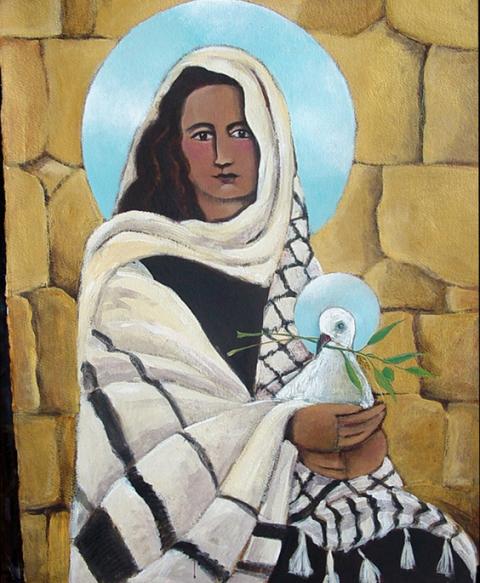
Mickey McGrath's Madonna painting depicts her wearing a traditional Palestinian veil, with a background of the Wailing Wall, where Jews in Jerusalem go to pray, symbolizing the unity of peoples in the peace offered by Mary. (Courtesy of Mickey McGrath)
His relationship with these sisters actually started in 1993, shortly after the deaths of McGrath's parents, when he first visited their monastery. Inspired by the sisters and their predominantly Black neighborhood, McGrath was commissioned to create a painting of the Visitation — Mary's visit to Elizabeth — that reflected the diverse women of the area, to replace one in which Mary and Elizabeth looked like "two German blonde Renaissance chubby women."
Some of the most distinct Madonnas that the American public could appreciate in exhibitions, shows, retreats and books created by McGrath in the 2000s include several Black Madonnas. "Our Lady of Sorrows" represents Mary as an older Black woman in light-colored clothing, immersed in nocturnal landscapes.
Another McGrath Madonna from the same period as McGrath's is depicted wearing a traditional Palestinian veil, but with a background of the Wailing Wall, where Jews in Jerusalem still go to pray, symbolizing the unity of peoples in the peace offered by Mary.
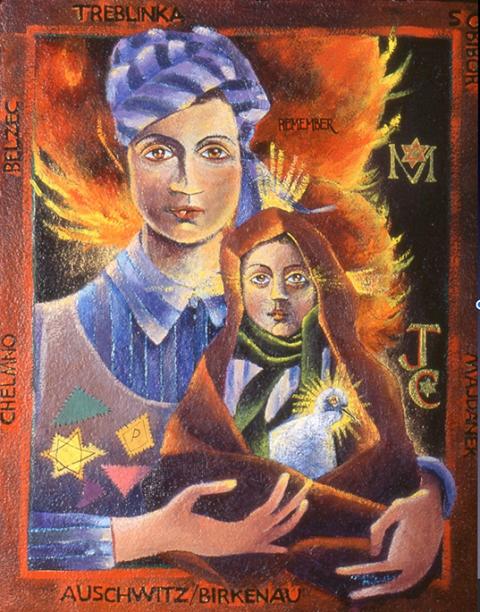
In a painting Mickey McGrath calls "Our Lady of Auschwitz," Mary is depicted as a Jewish prisoner of a concentration camp. (Courtesy of Mickey McGrath)
In another referred to by McGrath as "Our Lady of Auschwitz," Mary is depicted as a Jewish prisoner of a concentration camp, with the flames of the Nazi-built crematoriums in place of an aura, and baby Jesus wrapped in a brown cloth as if to represent the thousands of Jewish children who were hidden by their mothers during the Holocaust years to escape the concentration camps, which are listed at the edges of the painting.
As he delved into the history, McGrath uncovered the little-known Jewish heritage of St. Teresa of Ávila, whose grandfather, a successful Jewish merchant in Toledo, Spain, converted to Catholicism under duress during the Spanish Inquisition. Despite his conversion, he and his descendants, including Teresa, faced ongoing suspicion and discrimination. This historical context was not widely known until after the Holocaust, raising questions about how much Teresa might have known about her Jewish roots.
McGrath also became fascinated by the early life of St. Titus Brandsma, a Carmelite friar known for his intellectual pursuits and kindness despite his frail health. During the Nazi occupation of the Netherlands, Brandsma, who was a journalist, worked closely with the archbishop of Utrecht to resist Nazi propaganda in Catholic newspapers. His efforts led to the persecution of Catholic converts from Judaism, including Edith Stein.
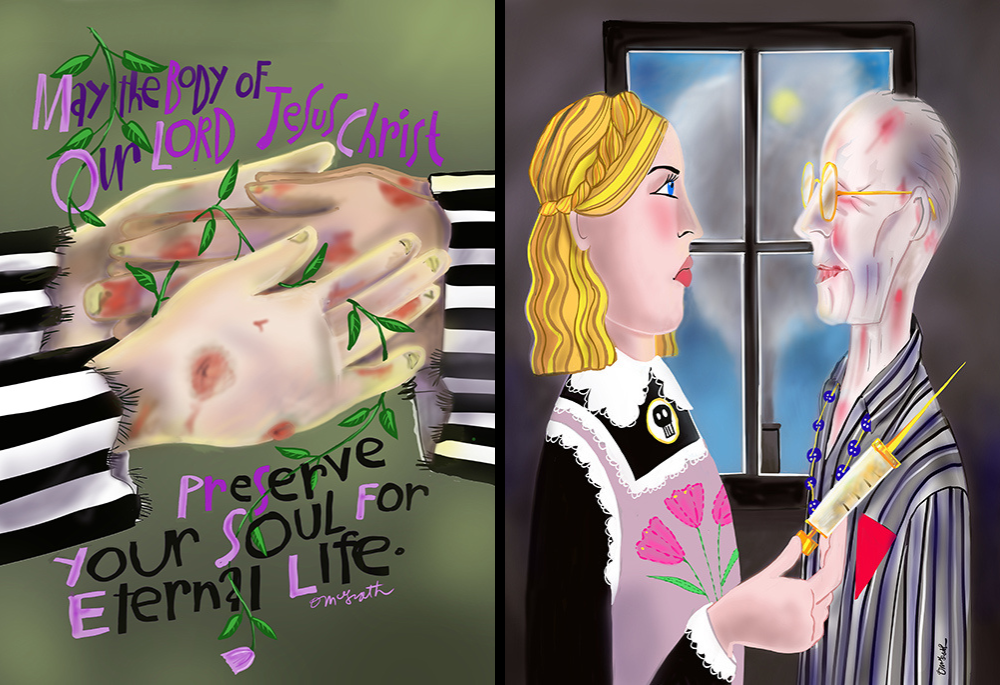
At left, McGrath depicts St. Titus Brandsma, who was imprisoned and killed at the Dachau concentration camp. "When Brandsma would occasionally manage to secretly celebrate a Mass at Dachau, in the absence of eucharistic bread, he'd take the other prisoners' hands in his and say, 'This is the body of Christ,' " McGrath said. At right, McGrath depicts Brandsma and the nurse at Dachau who ultimately administered the injection that killed him. (Courtesy of Mickey McGrath)
Eventually, Brandsma was arrested by the German Gestapo, enduring imprisonment and torture with remarkable calm and faith. His final days were spent in the Dachau concentration camp, where he continued to inspire and comfort his fellow prisoners, even forgiving the nurse who ultimately administered the lethal injection that ended his life. That Nazi nurse, McGrath said to NCR, was later called to testify anonymously at the Vatican in the 1960s about her experience of spiritual transformation at the concentration camp she had through Brandsma's forgiveness.
"When Brandsma would occasionally manage to secretly celebrate a Mass at Dachau, in the absence of eucharistic bread, he'd take the other prisoners' hands in his and say, 'This is the body of Christ,' " McGrath said.
In 2023, McGrath was awarded the Marianist Award from the University of Dayton, given to Catholics whose work has made a major contribution to the intellectual life of the church. "I was thrilled and honored and humbled to receive it because I never thought of myself in that light before," he said. "It has given me new insights of self-awareness and a deeper recognition that art and beauty really are the best proofs of the Holy Spirit's presence in the world. Beauty unifies human hearts."
McGrath said this award was one of the "big factors" that helped him move into the next phase of his life, that he said he likes to call his "senior, reflective years," adding that he no longer feels he has to prove himself or work for recognition. "I am happy with who I am and the work and gifts I have been given," he said.








